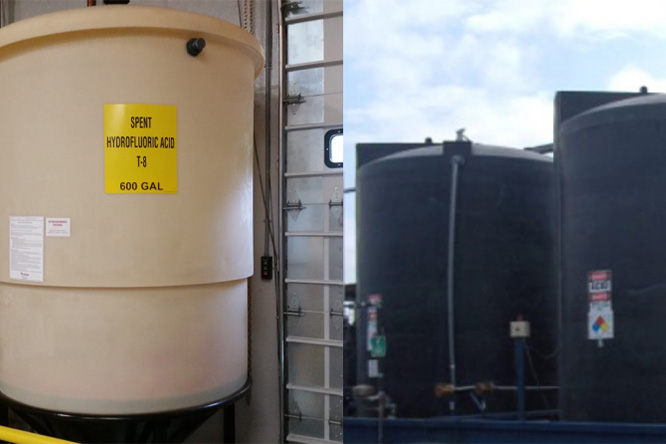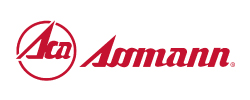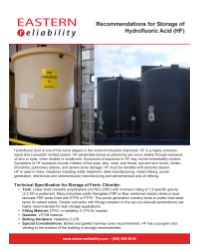Recommendations for Storage of Hydrofluoric Acid (HF)
Hydrofluoric Acid is one of the worst players in the world of industrial chemicals. HF is a highly corrosive liquid and a powerful contact poison. HF penetrates tissue so poisoning can occur readily through exposure of skin or eyes, when inhaled or swallowed. Symptoms of exposure to HF may not be immediately evident. Symptoms of HF exposure include irritation of the eyes, skin, nose, and throat, eye and skin burns, rhinitis, bronchitis, pulmonary edema, and severe bone damage. HF must be handled with extreme caution. HF is used in many industries including water treatment, steel manufacturing, metal refining, power generation, electronics and semiconductor manufacturing and petrochemical and oil refining.

Technical Specification for Storage of Hydrofluoric Acid:
- Tank:
Linear lined Cross-link polyethylene (XLPE/LLDPE) with minimum rating of 1.9 specific gravity (2.2 SG is preferred). Many industries prefer fiberglass (FRP or fiber reinforced plastic) tanks or dual laminate FRP tanks lined with ETFE or PTFE. The power generation industry tends to prefer lined steel tanks for added safety. Double wall tanks with fittings installed on the top (no sidewall penetrations) are highly recommended for bulk storage applications. - Fitting Material:
Polypropylene, CPVC or hastelloy C-276 for nozzles - Gaskets:
VITON material - Bolting Hardware:
Hastelloy C-276 - Special Considerations:
Bolted and gasket manway cover recommended. HF has a pungent odor. Venting to the exterior of the building is strongly recommended.
Secondary Containment
End users should check local regulations to meet secondary containment requirements. Containment must be adequate in capacity and suitable for HF. By accepting the delivery of the tank, the customer accepts full responsibility for providing appropriate and adequate containment for the stored material. Eastern Reliability offers a variety of secondary containment options.
Connections
Eastern Reliability’s recommendation is to install all fittings on the top of the tank. When this is not possible, connections below liquid level must prevent the chemical from contacting tank wall cross section.
Sidewall connections should be installed a minimum of 7" above the tank floor. Internal siphon drains can be used if required. Sidewall connections should be kept to a minimum amount and should be placed no closer than 22° apart. Whenever possible, sidewall connections should not be greater than 3". There are no restrictions on dome fittings.
Flexible Hoses or Expansion Joints (not required for FRP tanks)
Flexible hoses or expansion joints must be used on all lower 1/2 sidewall connections. A lightweight isolation valve is permitted prior to the flexible joint. Nipple and valve weight must not exceed 8 lbs. All piping must be supported independent of tank. Pipe supports must be installed after the flexible joint to allow the tank to expand and contract under normal service conditions. Polyethylene tanks expand and contract both laterally and vertically; expansion hose or joint must accommodate for this expansion. Tank must maintain atmospheric pressure. Vents must be sized for a minimum of two times the largest inlet or outlet port for pneumatically filled tanks. Pump fill tank’s vent should be a minimum of one and a half times larger than the largest fill or discharge point. Tanks vented through a scrubber system, the vent size cannot be reduced passing through the scrubber. If a dispersion pipe is used in the scrubbing system, the pipe should not be submersed in more than 6" of liquid. A perforated dispersion pipe must allow for the same cross-sectional area of the pipe to prevent vent restriction. Under no circumstances should tank be placed under pressure or vacuum conditions.
Hydrofluoric Acid
Make sure that hydrofluoric acid does not exceed 100°F, under any circumstance, at delivery or during storage. When practical, tanks should be kept from direct sunlight to avoid excessive heat.
Excessive heat will degrade the chemical and will accelerate chemical reaction with tank materials. Heat will also cause additional off gassing and additional odors.
Delivery
All deliveries must be regulated. Maximum delivery pressures must not exceed 12 PSI. Ideally, hydrofluoric acid fumes should be vented back into delivery truck during offloading of chemical. If fume scrubbing system is being used, be sure that airflow through system is adequate to keep up with delivery pressure and airline surge. Under no circumstances should tank be placed under pressure or vacuum conditions.


